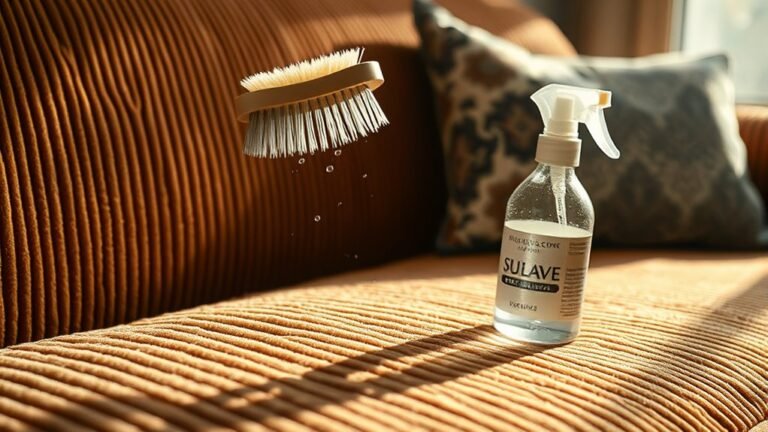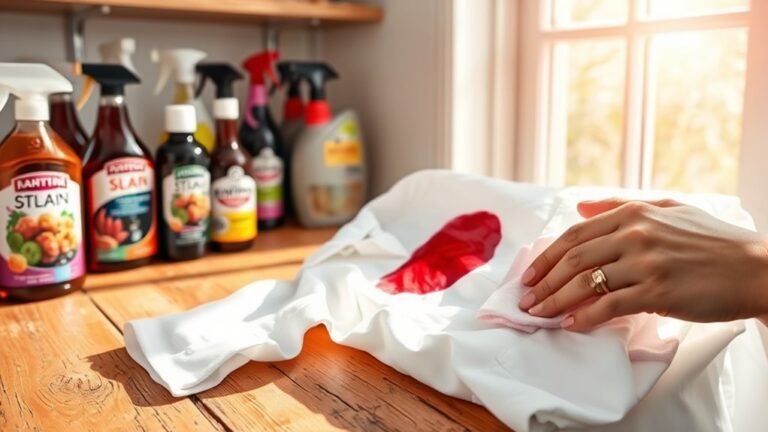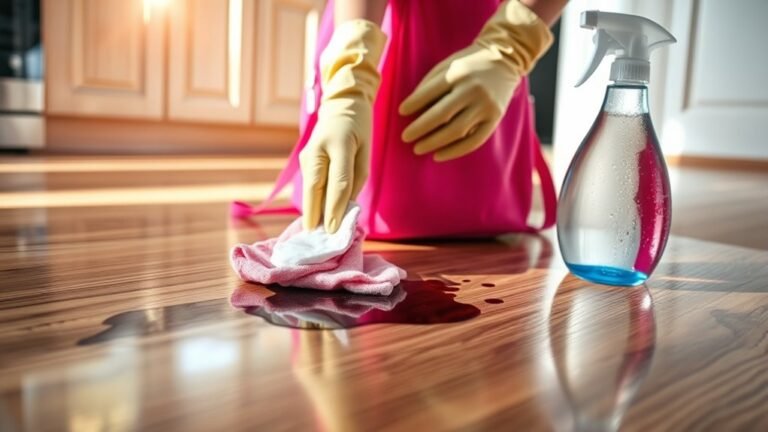Best Way to Sanitize Your Kitchen
The best way to sanitize your kitchen starts with clearing countertops and using warm, soapy water to wash surfaces, then applying a disinfectant spray to kill germs. Make sure to clean cutting boards, utensils, and sinks regularly with hot water and eco-friendly cleaners to prevent bacteria buildup. Establish daily wiping habits and weekly deeper cleans to keep your space healthy and safe. With the right tools and routines, your kitchen will stay fresh, inviting, and ready for anything ahead.
Understanding the Importance of Kitchen Sanitization

Although you might clean your kitchen regularly, understanding why proper sanitization matters is key to keeping your space truly safe. Kitchen hygiene goes beyond just tidying up; it’s about preventing harmful bacteria that can cause illness. When you focus on bacteria prevention, you reduce risks and protect your health and freedom to enjoy your meals without worry. Proper sanitization eliminates germs on surfaces, cutting down cross-contamination between raw and cooked foods. This simple practice empowers you to take control in your kitchen, ensuring a clean environment where your family can thrive. By prioritizing kitchen hygiene, you’re not just cleaning—you’re creating a safe haven, safeguarding your independence from preventable health setbacks.
Essential Tools and Supplies for Effective Sanitizing
To sanitize your kitchen effectively, you’ll need the right cleaning products, reliable equipment, and safe chemical alternatives. Choosing the right tools can make the process quicker and more thorough. Let’s explore what essentials you should have on hand for a spotless kitchen.
Must-Have Cleaning Products
Five essential cleaning products can make sanitizing your kitchen faster and more effective. First, eco friendly cleaners let you protect your space without harming the environment or your health. Second, multi surface wipes are a must—they save time by quickly tackling countertops, appliances, and handles in one swipe. Third, a good disinfectant spray guarantees germs don’t stand a chance. Fourth, a quality dish soap helps remove grease and grime before sanitizing. Finally, microfiber cloths are perfect for scrubbing and drying without leaving streaks. With these products, you’re equipped to keep your kitchen spotless while maintaining your freedom to choose safer, smarter cleaning solutions. You don’t have to sacrifice effectiveness for eco-consciousness—it’s all about picking the right essentials.
Effective Sanitizing Equipment
Along with the right cleaning products, having the proper tools and supplies makes sanitizing your kitchen more efficient and thorough. Using reliable sanitizing tools guarantees you reach every corner, while regular equipment maintenance extends their life and effectiveness. Here’s a quick guide to essential equipment:
| Equipment | Purpose | Maintenance Tip |
|---|---|---|
| Microfiber Cloths | Wipe surfaces | Wash regularly, air dry |
| Scrub Brushes | Tackle stubborn grime | Rinse after use |
| Spray Bottles | Apply sanitizers evenly | Clean nozzle frequently |
| Gloves | Protect hands | Replace when damaged |
| Sponges | General cleaning | Disinfect often |
Safe Chemical Alternatives
Why settle for harsh chemicals when there are safe alternatives that work just as well? You can take control of your kitchen’s cleanliness without compromising your health or the environment. Natural cleaners like vinegar, baking soda, and lemon juice offer powerful, non-toxic solutions to tackle grime and bacteria. Eco friendly disinfectants made from plant-based ingredients are another excellent choice, providing effective sanitizing without harmful fumes or residues. By opting for these safe chemical alternatives, you’re embracing freedom from harsh toxins and protecting your family’s well-being. Plus, these options are often biodegradable and sustainable, helping you reduce your ecological footprint effortlessly. So, equip your kitchen with natural cleaners and eco friendly disinfectants—you’ll enjoy a spotless, safe space that respects both you and the planet.
Step-by-Step Guide to Cleaning and Disinfecting Surfaces
Cleaning and disinfecting your kitchen surfaces properly involves a few essential steps that you can easily follow. First, clear your countertops and other work areas to improve kitchen organization and make cleaning straightforward. Next, identify your surface materials—whether granite, laminate, or stainless steel—so you use the right cleaning agents that won’t damage them. Start by wiping surfaces with warm, soapy water to remove dirt and grime. Rinse with clean water and dry with a cloth. Then, apply a suitable disinfectant and let it sit for the recommended time to kill germs effectively. Finally, wipe down with a clean cloth or paper towel. By following these steps, you’ll maintain a sanitized kitchen that supports your freedom to cook safely and confidently.
Proper Sanitization of Cutting Boards and Utensils

You’ll want to clean your cutting boards and utensils thoroughly to remove all food particles. Using the right sanitizing solutions guarantees harmful bacteria are eliminated effectively. Let’s look at simple techniques to keep these kitchen tools safe and hygienic.
Cleaning Techniques
Although it might seem straightforward, properly sanitizing cutting boards and utensils requires specific steps to prevent cross-contamination and keep your kitchen safe. You want to reflect on cleaning frequency—ideally after each use, especially when switching between raw meats and veggies. The surface materials of your boards and utensils matter too. Plastic boards are easier to clean thoroughly, while wooden ones need extra care to avoid absorbing bacteria. Use hot, soapy water to scrub all surfaces, paying close attention to grooves or cuts where germs can hide. Rinse well and dry completely to stop bacteria growth. By sticking to these cleaning techniques, you maintain your kitchen’s freedom from harmful pathogens without complicating your routine. Keeping it simple and consistent is the key to safe food prep every day.
Sanitizing Solutions
One of the most effective ways to sanitize your cutting boards and utensils is by using a proper sanitizing solution after cleaning. You want to guarantee every surface is free from harmful bacteria without relying on harsh chemicals that limit your choices. Sanitizing sprays made from natural disinfectants like vinegar, hydrogen peroxide, or essential oils offer a powerful, eco-friendly alternative. Simply spray your cutting boards and utensils thoroughly, let the solution sit for a few minutes, then rinse or air dry. This method not only keeps your kitchen safe but also respects your freedom to choose safer, non-toxic products. Embracing natural sanitizing sprays helps maintain cleanliness while supporting a lifestyle that values health and independence.
How to Safely Clean Kitchen Appliances
When cleaning kitchen appliances, it’s important to balance thorough sanitation with protecting their delicate components. Stick to regular cleaning schedules to avoid build-up and keep your appliances running smoothly. Before you start, check the appliance materials—some surfaces like stainless steel need specific cleaners, while others might be damaged by harsh chemicals. Unplug appliances to guarantee safety, and use a damp cloth with mild detergent for most surfaces. Avoid soaking electrical parts or using abrasive scrubbers that could scratch or damage finishes. For removable parts, soak them in warm, soapy water and dry completely before reassembling. By respecting your appliances’ materials and following a consistent cleaning routine, you’ll enjoy a hygienic kitchen without risking damage, keeping your cooking space fresh and efficient.
Tips for Maintaining a Germ-Free Sink and Drain Area

Keeping your kitchen appliances clean is just part of maintaining a sanitary cooking space. To truly keep your kitchen germ-free, focus on sink maintenance and drain cleaning. Your sink collects food particles and bacteria, so rinse it thoroughly after each use. Use a natural cleaner like baking soda and vinegar to scrub the basin weekly, breaking down grime without harsh chemicals. Don’t forget the drain—regular drain cleaning prevents clogs and bad odors caused by trapped debris. Pour boiling water down the drain once a week to flush away buildup. For a deeper clean, use a brush designed for pipes or a biodegradable drain cleaner. By staying consistent with these simple steps, you keep your sink and drains fresh and germ-free, empowering your kitchen freedom.
Best Practices for Regular Kitchen Sanitization Routine
Although daily life can get busy, establishing a regular kitchen sanitization routine is essential to prevent germs from accumulating. Start by dedicating a few minutes each day to daily cleaning—wipe down countertops, stove tops, and handles with a disinfectant. Keeping your kitchen organization simple helps you move faster and avoid missing spots. Don’t forget to clean cutting boards and utensils after each use, especially when handling raw foods. Once a week, sanitize your sink and mop the floor to tackle hidden bacteria. By making these steps a habit, you’ll enjoy a cleaner, safer kitchen without feeling overwhelmed. Embrace this routine as your ticket to freedom from kitchen germs, keeping your space fresh and ready for whatever culinary adventures come your way.
Frequently Asked Questions
Can Natural Ingredients Like Vinegar Replace Commercial Sanitizers?
You might wonder about vinegar efficacy as a natural alternative to commercial sanitizers. While vinegar does have some antibacterial properties, it’s not strong enough to eliminate all harmful bacteria and viruses. If you’re seeking freedom from harsh chemicals, natural alternatives like vinegar can help with light cleaning, but for thorough sanitizing, especially in food prep areas, it’s best to combine them with proper hygiene practices or use EPA-approved sanitizers to keep things truly safe.
How Often Should Kitchen Towels and Sponges Be Sanitized?
You should sanitize kitchen towels and sponges at least once a week to keep your kitchen hygiene on point. Towels can harbor bacteria fast, so washing them in hot water regularly is key for towel maintenance. Sponges soak up germs, so microwaving damp sponges for a minute or running them through the dishwasher helps. Staying consistent with this routine lets you enjoy a clean kitchen without feeling tied down by endless chores.
Are UV Sanitizers Effective for Kitchen Tools?
It’s funny how UV light, often seen in sci-fi, coincides with real-world kitchen tool safety today. You’ll find UV effectiveness in sanitizers can be pretty impressive, zapping bacteria and viruses quickly without chemicals. But don’t rely on it alone—UV doesn’t clean dirt or grease, so tools need pre-cleaning. If you want freedom from harsh chemicals and quick sanitizing, UV’s a great addition, but keep traditional cleaning as your foundation.
What’S the Best Way to Sanitize Reusable Grocery Bags?
When sanitizing reusable grocery bags, you’ll want to take into account the bag materials first—cotton, canvas, or synthetic fabrics each need different care. For washable fabrics, toss them in the washing machine with hot water and detergent. For non-washable ones, wipe down with a disinfectant wipe or spray and let air dry completely. Combining these cleaning methods guarantees your bags stay fresh and safe, giving you freedom to shop without worries.
How Does Kitchen Sanitization Impact Food Allergy Prevention?
Imagine you’re preparing a meal for a friend with peanut allergies. Kitchen sanitization plays a huge role in food allergy awareness and cross contamination prevention. By thoroughly cleaning surfaces and utensils, you reduce the chance of allergen traces mixing with safe foods. This simple step helps protect your loved ones and gives you the freedom to cook confidently, knowing you’re preventing dangerous allergic reactions before they happen.






